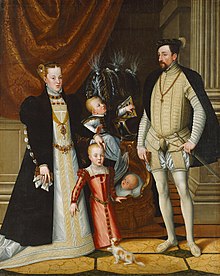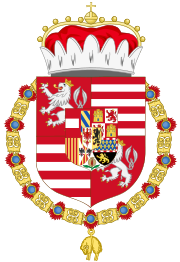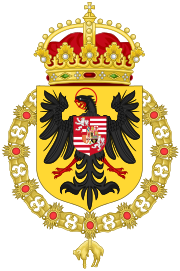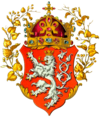Maximilian II, Holy Roman Emperor
| Maximilian II | |
|---|---|
Nicolas Neufchâtel, c. 1566 | |
| Holy Roman Emperor | |
| Reign | 25 July 1564 – 12 October 1576 |
| Predecessor | Ferdinand I |
| Successor | Rudolf II |
| Born | 31 July 1527 Vienna, Archduchy of Austria, Holy Roman Empire |
| Died | 12 October 1576 (aged 49) Imperial City of Regensburg, Holy Roman Empire |
| Burial | |
| Spouse | |
| Issue | |
Anna of Bohemia and Hungary | |
| Religion | Roman Catholicism |
| Signature | |
Maximilian II (31 July 1527 – 12 October 1576) was
Maximilian's rule was shaped by the confessionalization process after the 1555 Peace of Augsburg. Though a Habsburg and a Catholic, he approached the Lutheran Imperial estates with a view to overcome the denominational schism, which ultimately failed. He also was faced with the ongoing Ottoman–Habsburg wars and rising conflicts with his Spanish Habsburg cousins.
According to Fichtner, Maximilian failed to achieve his three major aims: rationalizing the government structure, unifying Christianity, and evicting the Turks from Hungary.[3] Peter Marshall opines that it is wrong to dismiss Maximilian as a failure. According to Marshall, through his religious tolerance as well as his encouragement of arts and sciences, he succeeded in maintaining a precarious peace.[4]
Biography
This section needs additional citations for verification. (June 2023) |
Maximilian was born in Vienna, Austria, the second child and eldest son of the Habsburg King Ferdinand I, younger brother of Emperor Charles V, Holy Roman Emperor, and the Jagiellonian Princess Anne of Bohemia and Hungary (1503–1547).[5] He was named after his great-grandfather, Emperor Maximilian I. At the time of his birth, his father Ferdinand succeeded his brother-in-law King Louis II in the Kingdom of Bohemia and the Kingdom of Hungary, greatly expanding the Habsburg monarchy.

Having spent his childhood years at his father's court in
Heir apparent
On 13 September 1548 Emperor Charles V married Maximilian to Charles's daughter (Maximilian's cousin) Maria of Spain[5] in the Castile residence of Valladolid. By the marriage his uncle intended to strengthen the ties with the Spanish branch of the Habsburgs, but also to consolidate his nephew's Catholic faith. Maximilian temporarily acted as the emperor's representative in Spain, however not as stadtholder of the Habsburg Netherlands as he had hoped for. To his indignation, King Ferdinand appointed his younger brother Ferdinand II administrator in the Kingdom of Bohemia, nevertheless Maximilian's right of succession as the future king was recognised in 1549. He returned to Germany in December 1550 in order to take part in the discussion over the Imperial succession.

Maximilian's relations with his uncle worsened, as Charles V, again embattled by rebellious Protestant princes led by Elector
The relationship between the two cousins was uneasy. While Philip had been raised a Spaniard and barely travelled out of the kingdom during his life, Maximilian identified himself as the quintessential German prince and often displayed a strong dislike of Spaniards, whom he considered as intolerant and arrogant.[6] While his cousin was reserved and shy, Maximilian was outgoing and charismatic. His adherence to humanism and religious tolerance put him at odds with Philip who was more committed to the defence of the Catholic faith.[7] Also, he was considered a promising commander, while Philip disliked war and only once personally commanded an army. Nonetheless, the two remained committed to the unity of their dynasty.

In 1551 Maximilian attended the
The religious views of the future King of Bohemia had always been somewhat uncertain, and he had probably learned something of
Reign
In November 1562 Maximilian was chosen King of the Romans, or German king, by the electoral college[5] at Frankfurt, where he was crowned a few days later, after assuring the Catholic electors of his fidelity to their faith, and promising the Protestant electors that he would publicly accept the confession of Augsburg when he became emperor. He also took the usual oath to protect the Church, and his election was afterwards confirmed by the papacy. He was the first King of the Romans not to be crowned in Aachen. In September 1563 he was crowned King of Hungary by the Archbishop of Esztergom, Nicolaus Olahus, and on his father's death, in July 1564, he succeeded to the empire and to the kingdoms of Hungary, Croatia and Bohemia.
The new emperor had already shown that he believed in the necessity for a thorough reform of the Church. He was unable, however, to obtain the consent of

Meanwhile, the relations between Maximilian and Philip of Spain had improved, and the emperor's increasingly cautious and moderate attitude in religious matters was doubtless because the death of Philip's son,
In 1576, Maximilian was
Maximilian died on 12 October 1576 in Regensburg while preparing to invade Poland. On his deathbed he refused to receive the last sacraments of the Church. He is buried in St. Vitus Cathedral in Prague.
By his wife Maria he had a family of ten sons and six daughters. He was succeeded by his eldest surviving son, Rudolf, who had been chosen king of the Romans in October 1575. Another of his sons, Matthias, also became emperor; three others, Ernest, Albert and Maximilian, took some part in the government of the Habsburg territories or of the Netherlands. His eldest daughter, Anna, married Philip II of Spain. Another daughter, Elizabeth, married Charles IX of France.
Religious policies
Maximilian's policies of religious neutrality and peace in the empire afforded its
He disappointed the German Protestant
Maximilian II was a member of the Order of the Golden Fleece.
Patronage of arts and sciences
Under Ferdinand I and Maximilian II, the imperial court itself became the centre of humanist scholarship. The court held close ties to the University of Vienna but the university, that reached its summit under Maximilian I, had been severely diminished due to wars and civil disturbances.[8][9]
In his court, Catholic and Prostestant scholars equally thrived. Many artists and scholars came from Spain, Italy and Spanish Netherlands.[10] Maximilian employed scholars like the botanist Carolus Clusius and the diplomat Ogier Ghiselin de Busbecq. Maximilian's library curated by Hugo Blotius later became the nucleus of the Austrian National Library. He implemented the Roman School of composition with his court orchestra, however, his plans to win Giovanni Pierluigi da Palestrina as Kapellmeister foundered on financial reasons.
Marriage and children

On 13 September 1548, Maximilian married his first cousin Maria of Spain, daughter of Emperor Charles V and Isabella of Portugal. Despite Maria's commitment to Habsburg Spain and her strong Catholic manners, the marriage was a happy one. The couple had sixteen children:
- Archduchess Anna of Austria (1 November 1549 – 26 October 1580). Married Philip II of Spain, her uncle. She became the mother of Philip III of Spain.
- Archduke Ferdinand of Austria (28 March 1551 – 25 June 1552).
- Rudolf II, Holy Roman Emperor (18 July 1552 – 20 January 1612).
- Governor of the Low Countries.
- Archduchess Elisabeth of Austria (5 July 1554 – 22 January 1592). Married Charles IX of France.
- Archduchess Marie of Austria (27 July 1555 – 25 June 1556).
- Matthias, Holy Roman Emperor (24 February 1557 – 20 March 1619).
- A stillborn son (20 October 1557).
- Archduke but never crowned. He served as grandmaster of the Teutonic Order and Administrator of Prussia.
- Archduke Albert of Austria (15 November 1559 – 13 July 1621). He served as Governor of the Low Countries.
- Archduke Wenceslaus of Austria (9 March 1561 – 22 September 1578).
- Archduke Frederick of Austria (21 June 1562 – 16 January 1563).
- Archduchess Marie of Austria (19 February 1564 – 26 March 1564). Named after her deceased older sister.
- Archduke Charles of Austria (26 September 1565 – 23 May 1566).
- Archduchess Margaret of Austria (25 January 1567 – 5 July 1633). A nun.
- Archduchess Eleanor of Austria (4 November 1568 – 12 March 1580).
Heraldry
| Heraldry of Maximilian II, Holy Roman Emperor | ||||||
|---|---|---|---|---|---|---|
|
Ancestors
| Ancestors of Maximilian II, Holy Roman Emperor | |||||||||||||||||||||||||||||||||||||||||||||||||||||||||||||||||||||||||||||||||||||||||||||||||||||||||||||||||||||||||||||||||||||||||||||||||||||||||||||||||||||||||||||||||||||||||||||||||||||||||||||||||||||||||||||||||||||||||||||||||||||||||||||||||||||||||||||||||||||||||
|---|---|---|---|---|---|---|---|---|---|---|---|---|---|---|---|---|---|---|---|---|---|---|---|---|---|---|---|---|---|---|---|---|---|---|---|---|---|---|---|---|---|---|---|---|---|---|---|---|---|---|---|---|---|---|---|---|---|---|---|---|---|---|---|---|---|---|---|---|---|---|---|---|---|---|---|---|---|---|---|---|---|---|---|---|---|---|---|---|---|---|---|---|---|---|---|---|---|---|---|---|---|---|---|---|---|---|---|---|---|---|---|---|---|---|---|---|---|---|---|---|---|---|---|---|---|---|---|---|---|---|---|---|---|---|---|---|---|---|---|---|---|---|---|---|---|---|---|---|---|---|---|---|---|---|---|---|---|---|---|---|---|---|---|---|---|---|---|---|---|---|---|---|---|---|---|---|---|---|---|---|---|---|---|---|---|---|---|---|---|---|---|---|---|---|---|---|---|---|---|---|---|---|---|---|---|---|---|---|---|---|---|---|---|---|---|---|---|---|---|---|---|---|---|---|---|---|---|---|---|---|---|---|---|---|---|---|---|---|---|---|---|---|---|---|---|---|---|---|---|---|---|---|---|---|---|---|---|---|---|---|---|---|---|---|---|---|---|---|---|---|---|---|---|---|---|---|---|---|---|---|---|
| |||||||||||||||||||||||||||||||||||||||||||||||||||||||||||||||||||||||||||||||||||||||||||||||||||||||||||||||||||||||||||||||||||||||||||||||||||||||||||||||||||||||||||||||||||||||||||||||||||||||||||||||||||||||||||||||||||||||||||||||||||||||||||||||||||||||||||||||||||||||||
Male-line family tree
In popular culture
- Maximilian II figures in José Saramago's 2008 novel The Elephant's Journey.
See also
- Kings of Germany family tree. He was related to every other king of Germany.
References
- ^ Maximilian II. (2009). In Encyclopædia Britannica Retrieved 20 May 2009, from Encyclopædia Britannica Online: https://www.britannica.com/EBchecked/topic/370517/Maximilian-II
- ^ Paula Sutter Fichtner, Historical dictionary of Austria ( 2009)
- ^ Paula Sutter Fichtner, Emperor Maximilian II (2001)
- ISBN 978-1-4464-2664-7. Retrieved 20 January 2022.
- ^ a b c Mutschlechner, Martin. "Maximilian II: caught between the competing priorities of Vienna, Prague and Madrid", Die Welt der Habsburger
- ^ Spain under Philip II, Perez
- ^ History of the Habsburg Empire, Jean Bérenger
- ISBN 978-1-351-95311-5. Retrieved 21 January 2022.
- ^ Janssen, Johannes (1909). History of the German People at the Close of the Middle Ages. K. Paul, Trench, Trübner, & Company, Limited. p. 213. Retrieved 21 January 2022.
- ISBN 978-1-351-91705-6. Retrieved 21 January 2022.
- ^ a b c d Chisholm, Hugh, ed. (1911). . Encyclopædia Britannica. Vol. 15 (11th ed.). Cambridge University Press.
- ^ a b c d Priebatsch, Felix (1908), "Wladislaw II.", Allgemeine Deutsche Biographie (in German), vol. 54, Leipzig: Duncker & Humblot, pp. 688–696
- ^ Wurzbach, Constantin von, ed. (1861). . Biographisches Lexikon des Kaiserthums Oesterreich [Biographical Encyclopedia of the Austrian Empire] (in German). Vol. 7. p. 112 – via Wikisource.
- ^ Boureau, Alain (1995). The Lord's First Night: The Myth of the Droit de Cuissage. Translated by Cochrane, Lydia G. The University of Chicago Press. p. 96.
- ^ Noubel, P., ed. (1877). Revue de l'Agenais [Review of the Agenais]. Vol. 4. Société académique d'Agen. p. 497.
Further reading
- Fichtner, Paula Sutter. Emperor Maximilian II (Yale University Press, 2001) ISBN 978-0-30008-527-3
- Fichtner, Paula Sutter. Historical Dictionary of Austria (Scarecrow Press, 2009) ISBN 978-0-81085-592-2




